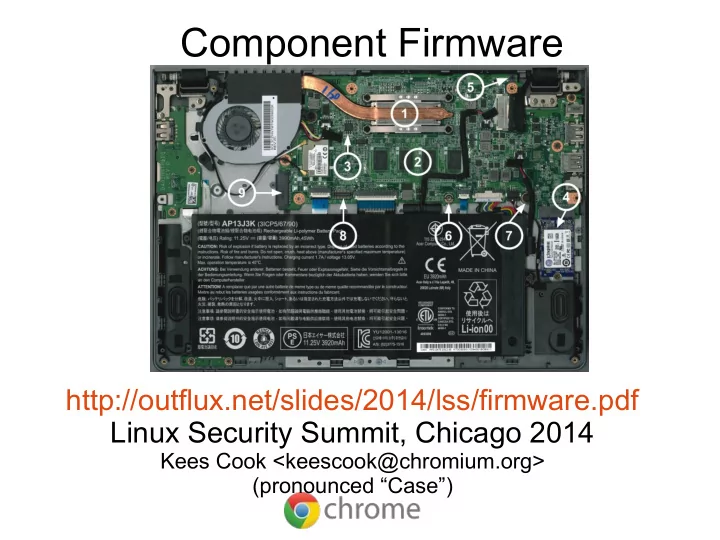

Component Firmware http://outflux.net/slides/2014/lss/firmware.pdf Linux Security Summit, Chicago 2014 Kees Cook <keescook@chromium.org> (pronounced “Case”)
Overview ● Wait, which firmware? ● Threats ● Update methods ● request_firmware() hooking ● Regression testing ● Future work Component Firmware 2/20 Linux Security Summit 2014 Aug 18, 2014
Wait, which firmware? ● Not the BIOS, UEFI, or other boot firmware – Though consider ME, SMM, TrustZone ● “Component Firmware” in system: – Network – Storage – Input – CPU – Other weird stuff Component Firmware 3/20 Linux Security Summit 2014 Aug 18, 2014
Threat: memory access ● Attached via DMA? – Example: network card ● Access to physical memory! ● Best protection is to configure IOMMU (when available) to limit the scope of attack http://esec-lab.sogeti.com/dotclear/public/publications/11-recon-nicreverse_slides.pdf Component Firmware Linux Security Summit 2014 Aug 18, 2014
Threat: interception and spoofing ● Attached to existing driver – Example: Bluetooth keyboard, drives ● On a similar bus? LPC devices can imitate legacy keyboards – Example: SuperIO and TPM are on LPC http://spritesmods.com/?art=hddhack https://online.tugraz.at/tug_online/voe_main2.getvolltext?pCurrPk=59565 Component Firmware Linux Security Summit 2014 Aug 18, 2014
Update methods ● None: actual ROMs ● Persistent? ● Over kernel or userspace exposed bus? ● Checksum? ● Signature? ● Documented? ● Once per boot? Component Firmware Linux Security Summit 2014 Aug 18, 2014
Read-only ● Code is part of chip mask ● Pros – Cannot be replaced with malicious code ● Cons – Cannot be replaced with bug-fixed code without physically replacing the chip Component Firmware Linux Security Summit 2014 Aug 18, 2014
Direct programmed ● Programmable chip but update mechanism not wired to anything ● Pros – Cannot be replaced with malicious code ● Cons – Cannot be replaced with bug-fixed code without physically attaching chip programmer Component Firmware Linux Security Summit 2014 Aug 18, 2014
Vendor-defined Crypto ● A chip has a vendor-supplied key loaded for crypto verification of the incoming firmware ● Pros – Secure firmware updates ● Cons – System owner has no access to change firmware – Uncommon for component vendors to implement Component Firmware Linux Security Summit 2014 Aug 18, 2014
System-defined Crypto ● A chip can have a key loaded for crypto verification of the incoming firmware ● Pros – Secure firmware updates – Key chain defined by system owner ● Cons – Very unlikely for component vendors to implement Component Firmware Linux Security Summit 2014 Aug 18, 2014
Per-power-on Toggle ● A chip will come up allowing updates, but once a flag is set, will reject further updates ● Pros – Secure firmware updates ● Cons – Only as secure as boot firmware – Updates must be applied during initial system boot – Boot firmware may need to re-flip bit across power events (e.g. suspend) Component Firmware Linux Security Summit 2014 Aug 18, 2014
Kernel-only bus ● The bus for communicating updates is only exposed to the kernel (e.g. reserved IO memory on PCI bus) ● Pros – Updates possible ● Cons – Only as secure as the kernel – Need kernel API to verify firmware origin Component Firmware Linux Security Summit 2014 Aug 18, 2014
Userspace bus ● The bus for communicating updates is exposed to userspace (e.g. SCSI generic, i2c, etc) ● Pros – Updates possible ● Cons – Crosses the line between userspace and ring0 – May not be limited to root user (e.g. 3G modem “AT” commands) Component Firmware Linux Security Summit 2014 Aug 18, 2014
request_firmware() ● Kernel drivers use this to get firmware loaded from userspace somewhere ● Designed for non-persistent firmware, covers a wide range of existing devices ● Go look in /lib/firmware Component Firmware Linux Security Summit 2014 Aug 18, 2014
kernel_fw_from_file() LSM hook /* * @kernel_fw_from_file: * Load firmware from userspace (not called for built-in firmware). * @file contains the file structure pointing to the file containing * the firmware to load. This argument will be NULL if the firmware * was loaded via the uevent-triggered blob-based interface exposed * by CONFIG_FW_LOADER_USER_HELPER. * @buf pointer to buffer containing firmware contents. * @size length of the firmware contents. * Return 0 if permission is granted. */ Component Firmware Linux Security Summit 2014 Aug 18, 2014
request_firmware() validation ● Check origin of fd (e.g. coming from expected read-only filesystem?) ● Check contents (e.g. against known signature) https://git.kernel.org/cgit/linux/kernel/git/kees/linux.git/log/?h=lsm/modpin Component Firmware Linux Security Summit 2014 Aug 18, 2014
Regression testing ● CONFIG_TEST_FIRMWARE creates test_firmware.ko that can be used to verify request_firmware calls ● Echo desired firmware name into /sys/devices/virtual/misc/test_firmware/trigger_ request ● Check /dev/test_firmware for resulting contents (or dmesg for errors) Component Firmware Linux Security Summit 2014 Aug 18, 2014
Demo! Component Firmware Linux Security Summit 2014 Aug 18, 2014
Future work ● What's the best way to intercept userspace APIs that allow firmware updates? ● How to convince vendors to implement once- per-boot updates? ● Can we modify existing component firmware to implement once-per-boot updates? Component Firmware 19/20 Linux Security Summit 2014 Aug 18, 2014
Questions? http://outflux.net/slides/2014/lss/firmware.pdf keescook@chromium.org keescook@google.com kees@outflux.net Component Firmware Linux Security Summit 2014 Aug 18, 2014
Recommend
More recommend